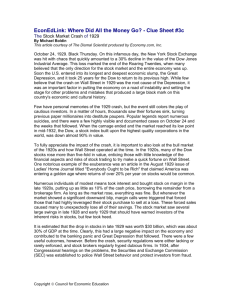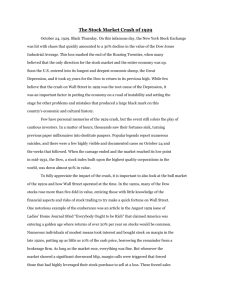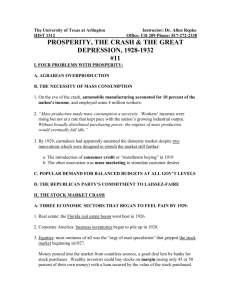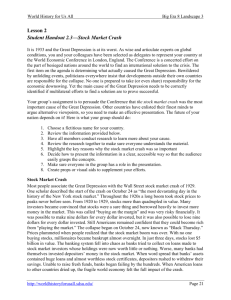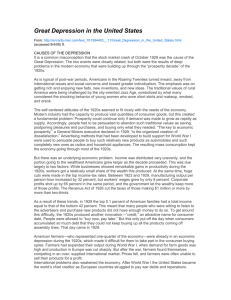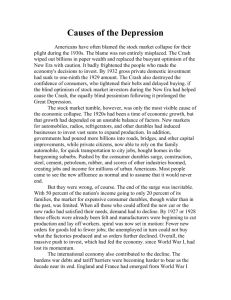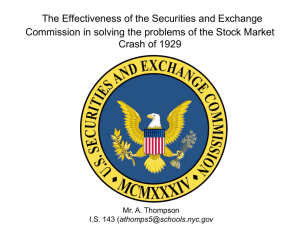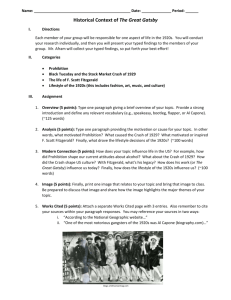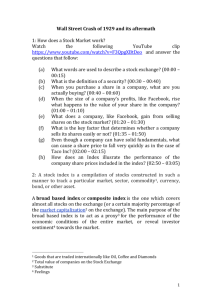EconEdLink: Clue Sheet #3c
advertisement
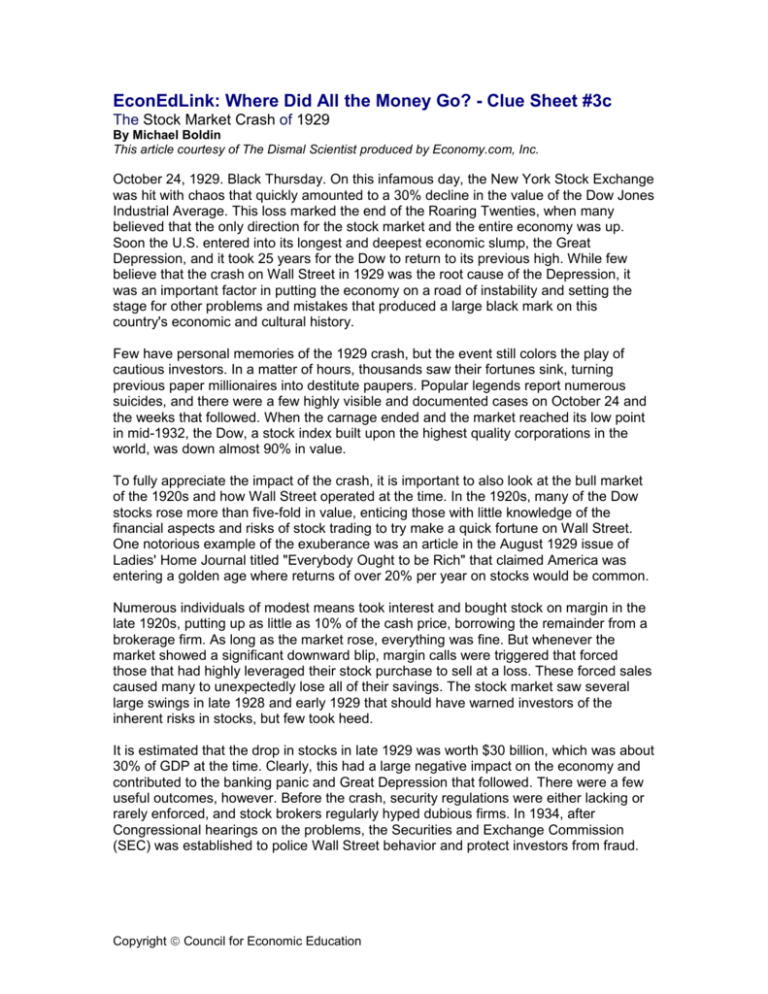
EconEdLink: Where Did All the Money Go? - Clue Sheet #3c The Stock Market Crash of 1929 By Michael Boldin This article courtesy of The Dismal Scientist produced by Economy.com, Inc. October 24, 1929. Black Thursday. On this infamous day, the New York Stock Exchange was hit with chaos that quickly amounted to a 30% decline in the value of the Dow Jones Industrial Average. This loss marked the end of the Roaring Twenties, when many believed that the only direction for the stock market and the entire economy was up. Soon the U.S. entered into its longest and deepest economic slump, the Great Depression, and it took 25 years for the Dow to return to its previous high. While few believe that the crash on Wall Street in 1929 was the root cause of the Depression, it was an important factor in putting the economy on a road of instability and setting the stage for other problems and mistakes that produced a large black mark on this country's economic and cultural history. Few have personal memories of the 1929 crash, but the event still colors the play of cautious investors. In a matter of hours, thousands saw their fortunes sink, turning previous paper millionaires into destitute paupers. Popular legends report numerous suicides, and there were a few highly visible and documented cases on October 24 and the weeks that followed. When the carnage ended and the market reached its low point in mid-1932, the Dow, a stock index built upon the highest quality corporations in the world, was down almost 90% in value. To fully appreciate the impact of the crash, it is important to also look at the bull market of the 1920s and how Wall Street operated at the time. In the 1920s, many of the Dow stocks rose more than five-fold in value, enticing those with little knowledge of the financial aspects and risks of stock trading to try make a quick fortune on Wall Street. One notorious example of the exuberance was an article in the August 1929 issue of Ladies' Home Journal titled "Everybody Ought to be Rich" that claimed America was entering a golden age where returns of over 20% per year on stocks would be common. Numerous individuals of modest means took interest and bought stock on margin in the late 1920s, putting up as little as 10% of the cash price, borrowing the remainder from a brokerage firm. As long as the market rose, everything was fine. But whenever the market showed a significant downward blip, margin calls were triggered that forced those that had highly leveraged their stock purchase to sell at a loss. These forced sales caused many to unexpectedly lose all of their savings. The stock market saw several large swings in late 1928 and early 1929 that should have warned investors of the inherent risks in stocks, but few took heed. It is estimated that the drop in stocks in late 1929 was worth $30 billion, which was about 30% of GDP at the time. Clearly, this had a large negative impact on the economy and contributed to the banking panic and Great Depression that followed. There were a few useful outcomes, however. Before the crash, security regulations were either lacking or rarely enforced, and stock brokers regularly hyped dubious firms. In 1934, after Congressional hearings on the problems, the Securities and Exchange Commission (SEC) was established to police Wall Street behavior and protect investors from fraud. Copyright Council for Economic Education Also, after 1929 many more economists and financial experts became interested in studying techniques for properly valuing stocks and giving advice on how to avoid financial panics. Their research has added to our knowledge about the economy and is at least partially responsible for the greater stability in many markets. A long-lasting negative effect of the 1929 crash was that many were turned off permanently toward stock investing. Few seem to know, however, that a purchase of diversified stocks even at their peak in 1929 would show a very healthy return (if held to today), especially compared to supposedly less risky bonds and bank CDs that historically have trouble keeping pace with inflation. Nonetheless, despite the high, long-run positive returns that stocks can show, many ask whether another crash could happen? In one sense, it already has. On "Black Monday," October 19, 1987, the Dow lost 23% in value. The difference between this case and 1929, however, was that the market soon stabilized and a year later it was hitting new highs. Black Monday of 1987 had little lasting impact on the economy, save for the adoption of additional rules for how Wall Street operates during a sudden decline. Still, some see stock prices as overvalued in 1999; broad stock indexes such as the S&P 500 show price-earning ratios of almost 35 compared to the historical average of 15. Therefore, a decline of 30% or more to move closer to historical fundamentals is conceivable, especially if some of the high-flying Internet stocks are hit with unexpectedly bad revenue and earnings news. However, it would surely take a second Great Depression to match the problems surrounding the 1929 crash that pushed stocks to one tenth of their previous high. Answer the following questions: 1. What factors bid stock prices up during the 1920s creating the "bull market"? _______________________________________________________________________ _______________________________________________________________________ _______________________________________________________________________ 2. How did the "bull market" unravel? _______________________________________________________________________ _______________________________________________________________________ _______________________________________________________________________ 3. What was the financial impact on investors and what did this do to the economy? _______________________________________________________________________ _______________________________________________________________________ _______________________________________________________________________ Copyright Council for Economic Education

